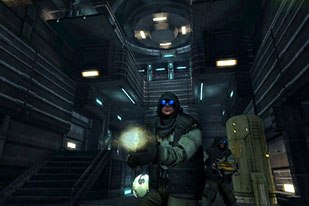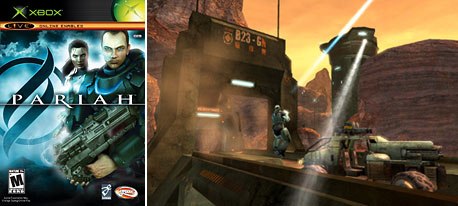Alain Bielik explores how MPC improved its motion capture and crowd simulation toolset for the siege of Jerusalem in Kingdom of Heaven.
With the advent of id softwares Doom in 1994, who wouldve known that the now grandfather of first person shooters (fps), wouldve begun a revolution and cult following for the genre. Although the technology was stellar for its time, a few generations have passed since the pixilated wonder first graced our PC screens. Fast forward a few generations and were still blasting aliens and human enemies away with high-powered weaponry and equally high-powered software and hardware. But now with such a saturated market plugged with juggernauts such as Unreal, Halo and Half-Life, where does Pariah stand amongst the best of the best? How has it changed since the once glorified days of Doom and more important how does it stack up to the aforementioned hits? With that question in mind, lets take a look at what makes Pariah tick and how Digital Extremes stays on the cutting edge of game development.
Pariah was roughly in development for about three years by developer Digital Extremes, which was later published by Groove Games. The game pits the player years into the future taking on the role as hero Jack Mason, a military doctor who has been called to Earth to transport a prison inmate who has contracted a deadly virus to an off-planet medical facility. The mission initially starts out as a routine transport mission, but as youre escorting the prisoner off-planet, your ship is shot out of the sky and you crash into the wastelands surrounding the prison, In the process, the story unfolds and the player finds himself in a world of intrigue and heart-pounding action.
Pariah was crafted for the Xbox, PC and PlayStation 2. Digital Extremes brought Pariah to life with their core 3D application, 3ds Max, and Character Studio as their animation tool. Their machines consisted mostly of Pentium 4 processors running at 2.0 to 2.8GHz, coupled with NVIDIAs GeForce 4 Ti 4200 and ATI Radeon 9800 graphic cards.
Digital Extremes utilized and built upon the existing Unreal Engine 2 technology. This gave the developers the unprecedented support they needed, utilizing the powerful editor, animation support and its scripting language. The rendering engine were the main significant modifications the developers had to improve on, simply because they needed to give the engine the power it required to accomplish their goals, which included such new advanced features as normal mapping, and their in-house scripted localized distortion for grenade and rocket explosions, full screen bloom lighting and full screen blur for healing and sprinting. With the addition of pixel and vertex shader support most of the rewriting of the render pipeline occurred on the Xbox version of the game, this coincided with additional new scripts were the bulk of changes.
The in-game characters and environments consisted of an almost surreal photorealistic look and feel to them. This is quite a surprising feat considering the highest poly characters on screen at a given time consisted of 5,000, whereas the minor characters averaged around 2,700. And according to James Schmalz (creative director at Digital Extremes), each main character in the game is composed of, on average, about 4,000 polygons, which he says is two to three times as many polygons as the studio was able to pack into a typical character in previous games. The vehicles are equally impressive, clocking in at around 3,000 polys per vehicle.
Although the environments garnished most of the on screen resources and in their own right they were quite noteworthy and stunning most of the time, averaging anywhere from 70,000 to 500,000 polys, they were still quite a few scenes where the sharp angular edges of the architecture deterred my gaming experience just a bit. But when its all said and done, Pariah did a good job of pulling the gamer into its eerily organic world.

One of the many nuances Ive experienced as a gamer is poor character AI. Although Pariah doesnt break a new mold in this realm, it does a well enough job to keep you pushing forward to experience the unfolding story. According to Jim MacArthur (programmer at Digital Extremes), The AI is a very complex set of states. The AI chooses what to do next based on his situation. So for example an enemy that takes cover when taking fire to enemies that charge and are aggressive as well as enemies working in teams or lone rangers. He went on to say there is a heavy CPU cost associated with running complex AI on many characters so some of the AIs would have simplified AI or limitations. This was very evident with some of the soldiers as they did either two things, charged after you shooting are just take cover and shoot. The AI wasnt as organic as I wouldve like to see, simply based on the fact that I could literally reload my weapon right in front of an enemy solider, and hell just wait for me to finish, then either fire at me or if I was close enough, give me a few punches. Although this happened in a handful of situations and granted the difficulty couldve played a role in their behaviors, it wasnt immediately apparent and it was enough to jar the experience.
Drawing from MacArthurs explanation, I think weve seen the limit to this generation of gaming when it comes to enemy AI or AI in general. To which, MacArthur replied: In Pariah we took the already great Unreal AI and added more to have them work in a single-player environment some examples included ranking them from light enemies to medium and heavy enemies. With that said, we can expect and experience much more robust AI routines in similar settings, given the added power of the next generation console and PC systems.
As previously mentioned, the in-game graphics were quite impressive, to the point were it actually felt like compressed pre-rendered sequences. This was one of the many reasons why the in-game cinematics were handled by the games engine itself. Digital Extremes opted to use Unreal 2s engine for their cinematics because they wanted to keep the game flowing with the same look and feel without the interruption of a pre-rendered sequences, which would somewhat take you out of the experience and pace the game sets, without the pre-rendered sequences, MacArthur said this would help marry the game together. As the future of gaming progresses, I can see in-game cinematics become more dominant as the technology leap would allow such prowess, some would even argue that were already there with cinematics seen in other fps such as Halo 2. This would essentially cut down on the unnecessary task of creating new assets, pre-rendering them and integrating them into the game, hence significantly cutting down on the time it would cost in a production cycle.

The in-game animations relied a lot on the heavy use of MoCap utilizing Character Studio, MoCap was used for a majority of the animations in the game and it shows. It wasnt distracting in the least but quite welcomed based on the genre of the game. Most of the MoCap data was tweaked but in some cases, such as the cinematics, it was keyframed entirely by the animators.
Everything in the game moved and behaved in a very realistic manner. If it wasnt the human characters, it was the slight sway of the trees, the gentle breeze of the grass or the falling leaves and additional particle effects. Visually it was quite pleasing and Im really happy that Digital Extremes paid attention to those small details and it really made a difference in gameplay.
The only aspect of the animations that I would say needed some more polish or refinement are the lip sync and eye blinks, which appeared very scripted and not organic in the least. The eyebrow movements were convincing enough but all other facial features were very linear and lifeless. But to be fair, not many developers do this because of the consuming process that accompanies it.
Although Pariah doesnt break a lot of new ground, its good that Digital Extremes really went that extra step to provide a lot of small details that usually go unrealized by other developers, such as destructible environments and an almost living breathing world.
With the advent of normal mapping, more complex AI routines and more polygon counts per character, Im on the edge of my seat in anticipation of whats next to come from the next generation of gaming. And Digital Extremes shares my views as theyre already in production of their next gen adventure, Dark Sector, but thats another story.
Tito A. Belgrave is currently a 3D artist for DKP Studios in Toronto and freelance writer, who is currently working on the companys first ever feature length animated film. When not involved in a tight day-to-day schedule, he spends time with his lovely wife and works on his short film, The Tale of Kar.









